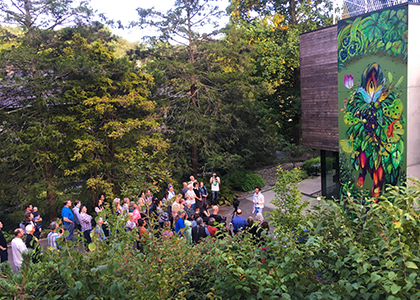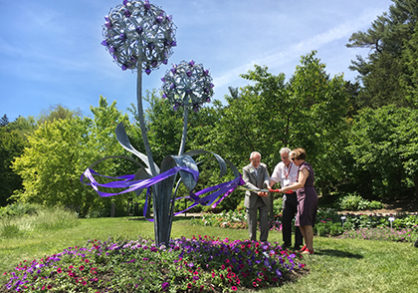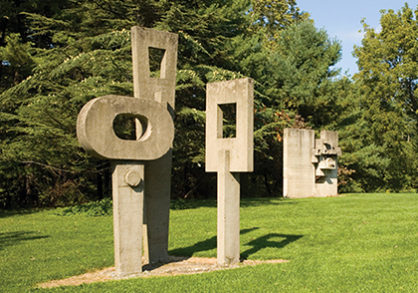
Cornell Botanic Gardens has unveiled a new outdoor art installation: a two-story mural, created in September 2019 by Brazilian street artist Eder Muniz.
“A Dança Da Natureza” (The Dance of Nature) incorporates nature, a human figure, animals and stylistic images in bright, vivid colors that enliven the north side of the Nevin Welcome Center. The mural expresses the aura and spirit of plants, with the artist seeing and capturing the colors of nature in ways undetected by most.
The grounds of Cornell Botanic Gardens remain open during statewide efforts to contain the spread of COVID-19, although the Nevin Welcome Center is closed. Visitors are asked to strictly observe social distancing by maintaining a distance of 6 feet from others, no groups of any size will be allowed, and visitors are asked to refrain from interacting with staff.
Muniz was selected for the project because of his commitment to using his artistry to inspire a dialogue with the public about the balance between humans and nature. With its energy, rich colors and warmth, his work represents Cornell Botanic Gardens’ passion for plants and desire to help people appreciate and connect with them differently.
“Plants for me are the base of everything. Without plants we are not connected to other things,” Muniz said. “Nature is a big surprise all the time. In terms of harnessing the ‘magic’ from the setting, it’s no great surprise – everything is right there!”
Cornell Botanic Gardens commissioned the mural as part of its goal to nurture the unique and personal connections people and cultures have to plants. As visitors round the northeast corner of the welcome center, they encounter the mural, set among the plant collections it depicts and paired with flora from more tropical climes.
“I had sketched the mural, but on arriving at Cornell Botanic Gardens, I was inspired because there were so many kinds of flowers and plants, textures and shapes, forms and colors, too,” Muniz said. “I took a walk in the garden and realized the significance of place, and continued to take walks every day, even after the mural was finished.”
The mural is a striking, artistic expression of the gardens’ strategic direction – to connect people and plants for a world of diversity, beauty and hope, said Christopher Dunn, the Elizabeth Newman Wilds Director of Cornell Botanic Gardens.
“We hope it will touch visitors and inspire them to better understand the essential interdependence between plant diversity and human cultural diversity,” Dunn said.
Muniz helped transform the streetscapes of Salvador, Brazil, through the magic of his art. Fourteen years ago, the mayor of Salvador collaborated with graffiti artists who were part of Muniz’ artist movement known as Calangos. The movement strives to empower graffiti artists to replace tag-ridden streetscapes with social messages using images and art, improving lives of artists and beautifying the city. Today the project employs 43 young artists and has changed the face of Salvador.
Muniz’ mural at Cornell Botanic Gardens was supported, in part, by a grant from the Cornell Council of the Arts, a university-wide cultural organization that provides a platform for the creation of and public discourse on the contemporary arts on campus. While in residence, Muniz presented the Class of 1945 Lecture in Cornell Botanic Gardens’ Fall Lecture Series: “Using Street Art to Inspire a Balance Between Humans and Nature.”
He also discussed his art form, inspiration and process with students in two classes: Introduction to Print Media (ART 2301) and The Art of Horticulture (PLHRT 2010). Student art inspired by Muniz’s mural will be on display at the Nevin Welcome Center, when coronavirus containment efforts lift and the center reopens.
Two-story mural nurtures connections with plants
View this short video of Brazilian street artist Eder Muniz creating a mural in bright, vivid colors, enlivening the north side of the Nevin Welcome Center.
Towering ‘Double Allium’ installed at Botanic Gardens
Anne Simon Moffat ’69 and husband Keith Moffat commissioned the sculpture, which was dedicated June 8 during Reunion weekend.
Sculpture Garden
These abstract, ten-ton concrete sculptures were created in the 1960s by Cornell undergraduate architecture students.


